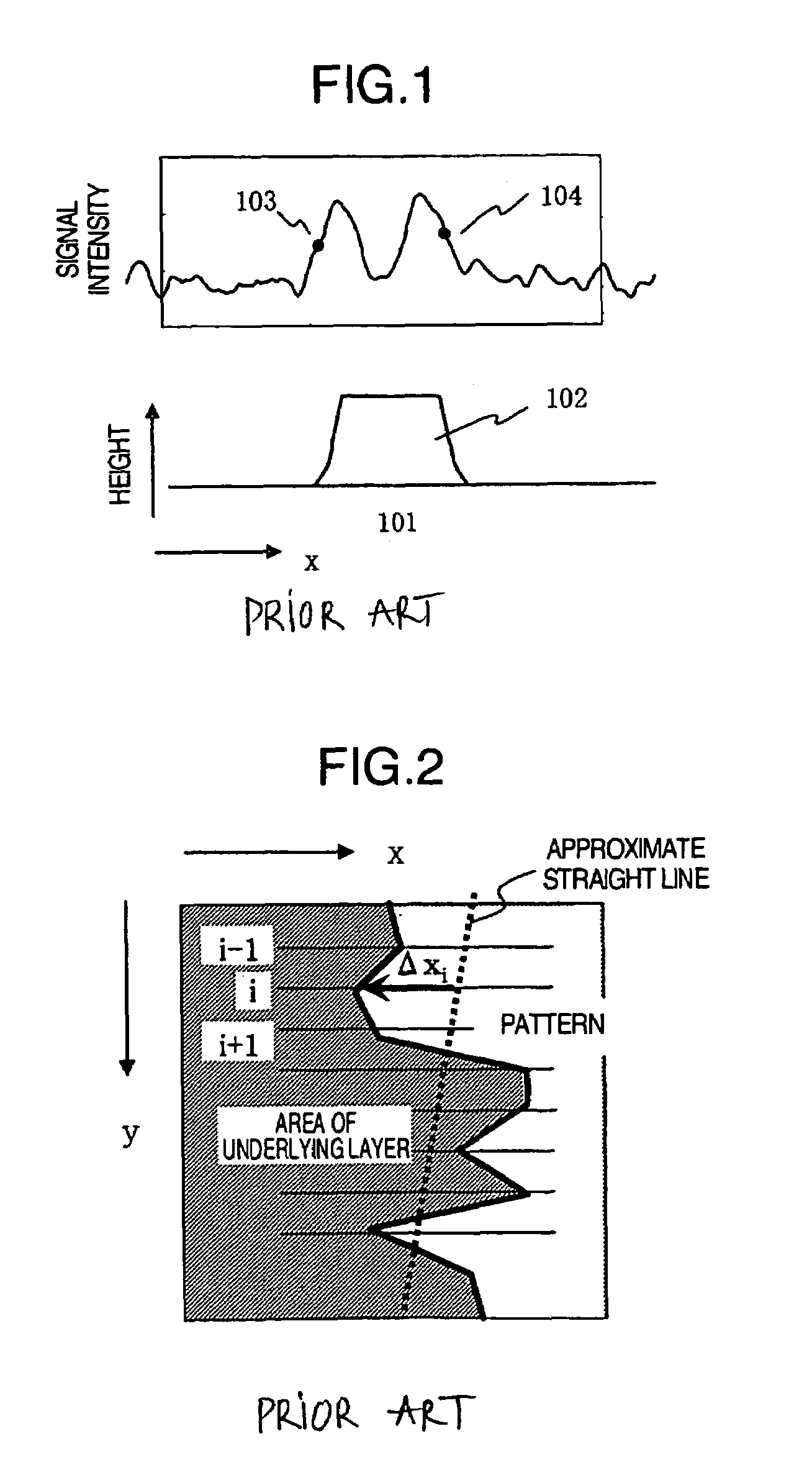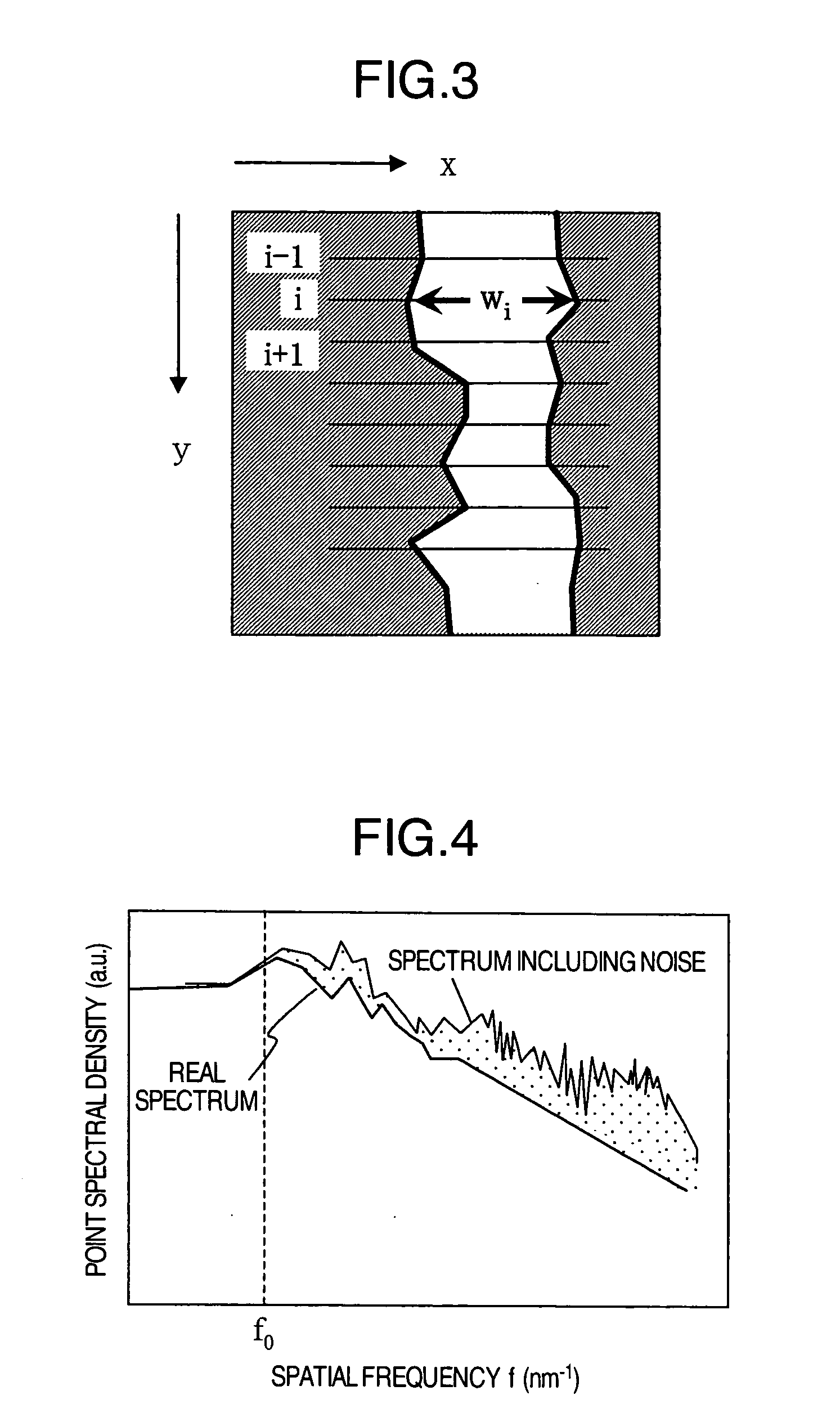High-accuracy pattern shape evaluating method and apparatus
a pattern shape and high-accuracy technology, applied in the direction of material analysis using wave/particle radiation, instruments, etc., can solve the problems of high method cost, high method cost, and damage to specimens, and achieve the effect of finer pattern shape evaluation, high accuracy roughness measurement, and easy short-term performan
- Summary
- Abstract
- Description
- Claims
- Application Information
AI Technical Summary
Benefits of technology
Problems solved by technology
Method used
Image
Examples
embodiment 1
(Embodiment 1)
[0097]This embodiment illustrates application of the first method to a CD-SEM, which will be described next.
[0098]FIG. 18 schematically illustrates a hardware structure of the CD-SEM used in this embodiment. The CD-SEM mainly comprises housing 1801 of a scanning electron beam microscope that comprises an optoelectronic (or SEM) column and a specimen chamber, a control system 1811 for the microscope and information processor 1812. Information processor 1812 is connected to a data storage device 1813 that stores an obtained scanned electronic image and CAD data necessary for analyzing purposes. Data storage device 1813 can be provided within information processor 1812. Although not shown, information processor 1812 comprises an information input terminal that an operator of CD-SEM inputs information necessary for data processing to information processor 1812 and an image display means that displays a scanned electronic image acquired. A specified information input termin...
embodiment 2
(Embodiment 2)
[0116]The present embodiment relates to application of the second method to the CD-SEM, which will be described next. In order to describe the present embodiment, FIGS. 8, 9 and 10 will be used. The CD-SEM used in this embodiment has exactly the same hardware structure as the first embodiment. Thus, in the following, the description of Embodiment 1 concerning FIG. 18 will be used as requested.
[0117]FIG. 8 schematically illustrates a SEM image of a pattern analyzed in the embodiment. FIG. 9 illustrates a display picture obtained by repeating the resetting of averaging parameter S until S=3. A process ranging from the setting of examination areas 803 and 804 of FIG. 8 to acquisition of the power spectrum of FIG. 9 is exactly the same as that of Embodiment 1.
[0118]As described in Embodiment 1, advent of the circumstances in which the power spectrum density of the high frequency area was directly proportional to 1 / f2 when S=3 was confirmed visually. On the other hand, howe...
embodiment 3
(Embodiment 3)
[0123]The present embodiment relates to application of the third method described in “Summary of the Invention” to the CD-SEM, which will be described next. The image data analysis method which will be described in the present embodiment comprises obtaining an index of roughness and an index of random noise occurring in the image without performing Fourier' transform from data used to calculate the roughness in Embodiment 1. In the description of the present embodiment, FIGS. 8, 11–14 will be used. FIG. 8 schematically illustrates a SEM image of a pattern analyzed in the present embodiment. FIG. 11 is a flowchart of a calculation process performed in the present embodiment. FIGS. 12 and 13 are flowcharts each representing a part of the process of FIG. 11. FIG. 14 shows roughness indexes obtained from the image and a graph of a fitting curve as a result of the analysis. The CD-SEM used in the present embodiment is exactly the same structure as used in Embodiment 1. Thus...
PUM
| Property | Measurement | Unit |
|---|---|---|
| length | aaaaa | aaaaa |
| length | aaaaa | aaaaa |
| roughness | aaaaa | aaaaa |
Abstract
Description
Claims
Application Information
 Login to View More
Login to View More - R&D
- Intellectual Property
- Life Sciences
- Materials
- Tech Scout
- Unparalleled Data Quality
- Higher Quality Content
- 60% Fewer Hallucinations
Browse by: Latest US Patents, China's latest patents, Technical Efficacy Thesaurus, Application Domain, Technology Topic, Popular Technical Reports.
© 2025 PatSnap. All rights reserved.Legal|Privacy policy|Modern Slavery Act Transparency Statement|Sitemap|About US| Contact US: help@patsnap.com



